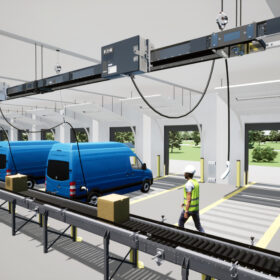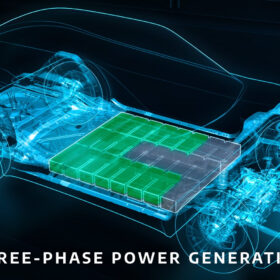Fraunhofer ISE integrates solar cells into car hood
Germany’s Fraunhofer Institute for Solar Energy (ISE) has advanced vehicle-integrated PV (VIPV) technology by installing solar cells directly onto a standard sheet-metal car hood. The researchers placed a 115 W prototype array on the hood of a Volkswagen with a specialized lamination process.
CATL unveils EV battery enabling a 400 km driving range on a 10 minute charge
Chinese battery industry heavyweight Contemporary Amperex Technology (CATL) announced a new electric vehicle battery that reportedly enables long-range driving on a fast, ten-minute charge. It expects mass production to begin by the end of this year, and vehicles equipped with the battery to be available in the first quarter of 2024.
Eaton introduces overhead EV fleet charging solution
Eaton, an Irish energy management specialist, has developed EV Charge Busway, an overhead power distribution solution that eliminates cable runs and major modifications to existing parking and conveyor structures.
Solar, storage, and V2G at the core of Israel’s future energy system
New research has shown that Israel has the technical potential to deploy 172.5 GW of photovoltaics, of which 132.1 GW would be from conventional installations and 40 GW from agrivoltaics. If deployed, this full potential would require energy storage with a capacity of at least 500 GWh and strong development of vehicle-to-grid technologies.
The EV station forecourts of the future
With electric vehicles (EVs) changing the face of motoring, Dover Fueling Solutions’ Lise-Lotte Nordholm considers what the service stations of the future could look like.
Carbon-cement supercapacitors for bulk energy storage
The Massachusetts Institute of Technology (MIT) has developed a scalable bulk energy storage solution with inexpensive, abundant precursors – cement, water, and carbon black. Their supercapacitors have high storage capacity, high-rate charge-discharge capabilities, and structural strength.
Recirculate – giving EV batteries a second-life
With the rapid growth in electric vehicle (EV) demand bringing fears of a mountain of EV battery waste piling up further down the line, the EU-Swiss government-funded Recirculate program is planning how to keep batteries in use for much longer before they head to recyclers.
Weekend Read: Much more than Goodenough
The world would have been a different place today had John Goodenough accepted the Shah of Iran’s $7 million offer, in 1974, to carry out solar research. Instead, he secured a job as the head of inorganic chemistry at the University of Oxford. During his tenure, he made a lithium-ion battery discovery that would affect the lives of almost everyone.
Stellantis, Saft unveil battery with integrated inverter, charger functions
After four years of development, French-Italian carmaker Stellantis, French battery company Saft, and the French National Center for Scientific Research (CNRS) have unveiled the Intelligent Battery Integrated System (IBIS), which integrates the electric charger and inverter functions. It can be used in automotive and stationary storage applications.
Tesla adds ‘Charge on Solar’ feature to Powerwall batteries
Tesla owners can select a feature in an app to set their Powerwall batteries to solely charge their vehicles on excess stored PV capacity.










